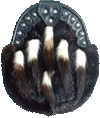

Official emblem of the Brotherhood. It is regarded as noble and is registered as such by the Office of Charters and by
the Lord Lyon King of Arms of Scotland,
Chief Heraldist of Her Most Gracious Britannic Majesty Elisabeth II.

National flower (plant badge) of Scotland, often paired with the device “Nemo Me Impune Lacessit” which means “Nobody worries me with impunity”,
in other words “gather thistles, expect prickles”. It is worn: “Argent” (silver) on a blue cordon by Knights, on a yellow one by Dignitaries
and on a green one by Officers;
“Or” (golden) on a red cordon by Senior Dignitaries and on a crimson one by the Grand Master.

Cross of Saint Andrew (white saltire on blue bottom) It is the official flag of Scotland as a country of the United Kingdom.
Counterchanged with the Cross of Saint Patrick (red saltire on white) for Ireland and with over all the Cross of Saint George (red cross on white) for Great Britain,
it contributes to form the famous Union Flag - also incorrectly called “Union Jack” - of the United Kingdom of Great Britain and Northern Ireland.

Special drinking bowl for toasting. Originally, they used a brimful hanap or bovine horn that each one drank up and then passed round.
So was shown the most enduring drinker (rather drunkard) during “ceidlidhs” (meetings of clan men).
Those rounds (drinkers used to sit in a ring) sometimes went on for one or two days and each one in his turn had to empty the quaich till only
one man remained sited.
Losers were thrown out by the Clan servants. Rich people more often used to drink wine but others drank barley-beer or
uisquebaugh (spirit that became whisky), which was still more redoubtable!

(Broadsword) Scottish duelling sword with a cross hilt and then (17th century) a basket hilt.
It is used for every induction.

Usually made of fur sometimes adorned with horsehair. It also may be a protection against tricky blows.

Scottish beret worn by Chieftains. In a wider sense, head-dress of Senior Dignitaries.

Forage-cap of the officers and pipers of Scottish regiments. The Brotherhood’s Dignitaries, Officers and Pipers wear it too.
(phonetic: sla:ndje) It means “good health!”.
It is said when toasting and is answered “slainthe mhath” (phonetic: sla:ndje vah), same meaning.

Scottish fabric distinctive of a Clan. Colours have been definitely fixed in the beginning of the 19th century.
The one in the margin is Clan Mackinlay’s tartan. Mackinlay being our “founder”, it is worn in dinner-jacket form by our Dignitaries and Knights.

It is worn in sash form by our Ladies of Honour.

Insignia worn by men on their balmoral or glengary and by ladies as a brooch to fasten the sash.